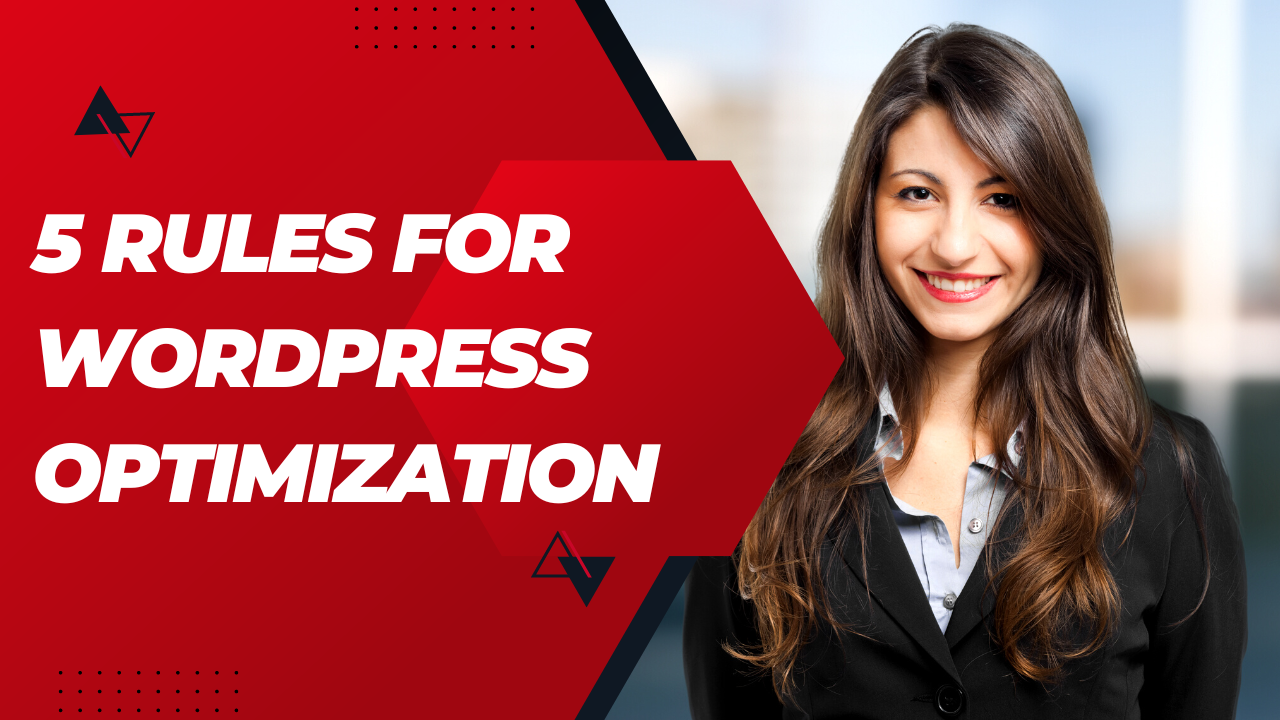Introduction
Welcome to our comprehensive WordPress optimization guide. In this article, we will delve into the intricacies of optimizing your WordPress website for peak performance, ensuring that it not only loads swiftly but also dominates search engine rankings. At [Our Company Name], we understand the significance of a well-optimized website, and we are here to equip you with the knowledge and strategies to outrank your competitors. Let’s dive right in!
Why WordPress Optimization Matters
In today’s fast-paced digital landscape, website speed and performance play a pivotal role in determining user experience and search engine rankings. With countless websites vying for attention, search engines favor those that offer excellent performance and deliver valuable content efficiently. By optimizing your WordPress website, you enhance its overall speed, user engagement, and, subsequently, its ranking potential.
Assessing Your Current WordPress Setup
Before embarking on the optimization journey, it is crucial to evaluate your website’s existing setup. Perform a thorough analysis of your WordPress configuration, plugins, themes, and hosting environment. Identifying areas that require improvement will help you develop a tailored optimization strategy.
Choosing a Lightning-Fast Hosting Provider
Selecting a reliable and high-performance hosting provider is the foundation of a well-optimized WordPress website. Look for a provider that offers robust infrastructure, advanced caching mechanisms, and excellent support. With an optimized hosting environment, your website will load faster, contributing to an enhanced user experience and improved search engine rankings.
Streamlining Your Theme
Your WordPress theme significantly impacts your website’s performance. Opt for a lightweight and well-coded theme that focuses on speed and efficiency. Avoid bloated themes with excessive features and elements that can slow down your website. By choosing a streamlined theme, you lay the groundwork for optimal performance and a competitive edge in search engine rankings.
Plugin Optimization
Plugins are a powerful asset in extending the functionality of your WordPress website. However, an excessive number of plugins or poorly optimized ones can negatively impact performance. Conduct an audit of your plugins and remove any unnecessary or outdated ones. Ensure that the remaining plugins are lightweight, regularly updated, and from reputable sources. This streamlined plugin ecosystem will contribute to faster load times and improved search rankings.
Optimizing Website Images
Images are an integral part of engaging web content, but they can also be a major factor in slowing down your website. To optimize your images effectively, consider the following steps:
- Image Compression: Use efficient image compression techniques or plugins to reduce the file size without compromising visual quality. This will drastically improve page load times.
- Image Dimensions: Resize images to match the required dimensions on your website. Avoid using oversized images and rely on responsive design principles for optimal display across various devices.
- Lazy Loading: Implement lazy loading techniques to load images only when they become visible to the user. This approach conserves bandwidth and speeds up initial page rendering.
By implementing these image optimization strategies, your WordPress website will deliver visually stunning content while maintaining lightning-fast loading speeds.
Caching and Content Delivery Networks (CDNs)
Leveraging caching mechanisms and Content Delivery Networks (CDNs) is a highly effective strategy for optimizing WordPress performance. Caching involves temporarily storing static versions of your web pages, reducing server load and enabling faster content delivery to users. Similarly, CDNs distribute your website’s content across various servers globally, ensuring faster loading times regardless of the user’s geographical location. Integrate a caching plugin and configure a CDN to unlock the full potential of your WordPress website’s performance.
Code Optimization and Minification
Cleaning up your website’s code is essential for optimizing performance. This involves eliminating unnecessary code, reducing file sizes, and minifying CSS and JavaScript files. Minification involves removing unnecessary characters, comments, and formatting without sacrificing functionality. Minified code improves loading times by reducing the amount of data that needs to be transmitted to the user’s browser.
To optimize your WordPress website’s code:
- Remove Unused Code: Perform a thorough review of your theme and plugins to identify and eliminate any unused or redundant code. This declutters your website’s codebase and improves overall performance.
- Minify CSS and JavaScript: Utilize tools or plugins that automatically minify your CSS and JavaScript files. Minification removes unnecessary characters, whitespace, and comments, resulting in leaner files that load faster.
- Combine and Load Files Asynchronously: Combine multiple CSS and JavaScript files into fewer files, reducing the number of requests made to the server. Additionally, load these files asynchronously to prevent them from blocking the rendering of your web pages.
By optimizing your WordPress website’s code, you enhance its performance, making it more appealing to both users and search engines.
Implementing Responsive Design
In today’s mobile-driven era, having a responsive website is crucial for superior user experience and improved search engine rankings. Responsive design ensures that your website adapts and displays correctly across a wide range of devices and screen sizes. By embracing responsive design principles, you provide a seamless browsing experience for users, regardless of the device they use to access your website.
Optimizing Website Navigation and User Experience
Website navigation and user experience are vital components of a well-optimized WordPress website. Consider the following strategies to enhance navigation and user experience:
- Clear Site Structure: Ensure your website has a logical and intuitive structure, making it easy for users to navigate through different sections and find the content they seek.
- Intuitive Menus: Use descriptive labels for navigation menus and organize them logically. Employ dropdown menus where appropriate to simplify navigation and improve user engagement.
- Internal Linking: Implement a robust internal linking strategy by interconnecting relevant pages within your website. This not only aids navigation but also helps search engines understand the relationships between different pages, improving their indexing and ranking potential.
- User-Friendly URLs: Optimize your website’s URLs by using descriptive, keyword-rich slugs that accurately reflect the content of each page. Avoid lengthy, cryptic URLs that can confuse users and search engines alike.
By focusing on website navigation and user experience, you create a positive impression on users while improving your website’s visibility in search engine results.
Content Optimization and Keyword Strategy
Crafting high-quality, keyword-rich content is paramount for outranking competitors and dominating search engine rankings. To optimize your WordPress website’s content:
- Keyword Research: Conduct thorough keyword research to identify relevant keywords and phrases that align with your target audience’s search intent. Use tools like Google Keyword Planner, SEMrush, or Moz to uncover valuable keywords with reasonable search volumes and low competition.
- Keyword Placement: Strategically incorporate your target keywords within your content, including headings, subheadings, and the body text. However, ensure that the keywords blend seamlessly with the natural flow of the content and provide value to the readers.
- Engaging and Informative Content: Create comprehensive, well-researched content that addresses the needs and queries of your target audience. Offer valuable insights, actionable tips, and relevant information that sets your content apart from competitors.
- Readability and Formatting: Format your content in a way that enhances readability. Use short paragraphs, bullet points, and subheadings to break up text and make it easier for users to scan and digest the information.
- Optimized Meta Tags: Craft compelling and keyword-rich meta titles and descriptions that accurately represent the content of each page. These tags not only improve search engine visibility but also entice users to click through to your website. optimization and implementing a strategic keyword strategy, you increase your chances of outranking competitors and achieving higher search engine rankings.
The Importance of Website Speed
Website speed is a critical factor that directly impacts user experience and search engine rankings. Slow-loading websites frustrate users and often lead to high bounce rates, negatively affecting your website’s visibility in search results. To optimize your WordPress website’s speed:
- Optimize Image Sizes: Compress images without compromising quality, ensuring they are appropriately sized for web display. This reduces the overall page size and improves loading times.
- Enable Browser Caching: Implement browser caching to store static files, such as CSS, JavaScript, and images, on users’ browsers. This allows subsequent page visits to load faster, as the cached files don’t need to be fetched again from the server.
- Minimize Redirects: Excessive redirects can significantly impact page load times. Reduce the number of unnecessary redirects and ensure that any essential redirects are optimized for speed.
- Enable GZIP Compression: Enable GZIP compression on your server to compress your website’s files before they are sent to users’ browsers. This reduces the amount of data transferred, resulting in faster page loading.
- Optimize Database: Regularly clean up and optimize your WordPress database to remove unnecessary data, such as spam comments, post revisions, and expired transients. This improves database performance and reduces page loading times.
Leveraging Social Media and Backlinks
In addition to on-page optimization, social media presence and backlinks can significantly impact your website’s search engine rankings. Consider the following strategies:
- Social Media Engagement: Establish an active presence on relevant social media platforms. Share valuable content, engage with your audience, and encourage social sharing of your posts. This increases visibility, drives traffic, and potentially generates backlinks.
- Backlink Building: Actively seek opportunities to acquire high-quality backlinks from reputable websites in your industry. Guest blogging, influencer collaborations, and creating valuable resources that other websites would want to link to are effective backlink-building strategies.
The Power of User Experience Metrics
Search engines consider user experience metrics, such as bounce rate, time on page, and click-through rate, as signals of website quality. By improving these metrics, you can enhance your website’s search engine rankings. Here are a few tips:
- Engaging Call-to-Actions (CTAs): Include clear and compelling CTAs throughout your website to encourage user interaction and guide them to take desired actions.
- Mobile Optimization: Ensure your website is fully optimized for mobile devices. Responsive design, fast loading times, and intuitive navigation on mobile devices contribute to a positive user experience.
- Optimized Landing Pages: Create landing pages that align with specific search queries or marketing campaigns. Craft compelling headlines, include relevant keywords, and provide valuable information to enhance user engagement and increase conversions.
- Easy Contact and Conversion Forms: Make it simple for users to contact you or convert by placing prominent and user-friendly contact and conversion forms on your website.
Conclusion
In conclusion, optimizing your WordPress website is a multi-faceted endeavor that involves various strategies and techniques. By implementing the guidelines provided in this comprehensive WordPress optimization guide, you can enhance your website’s speed, user experience, and search engine rankings. Remember to regularly monitor and analyze your website’s performance, make necessary adjustments, and stay updated with the latest industry trends to maintain your competitive edge. With dedication and a focus on continuous improvement, you can achieve peak performance and outrank your competitors in search engine results.

